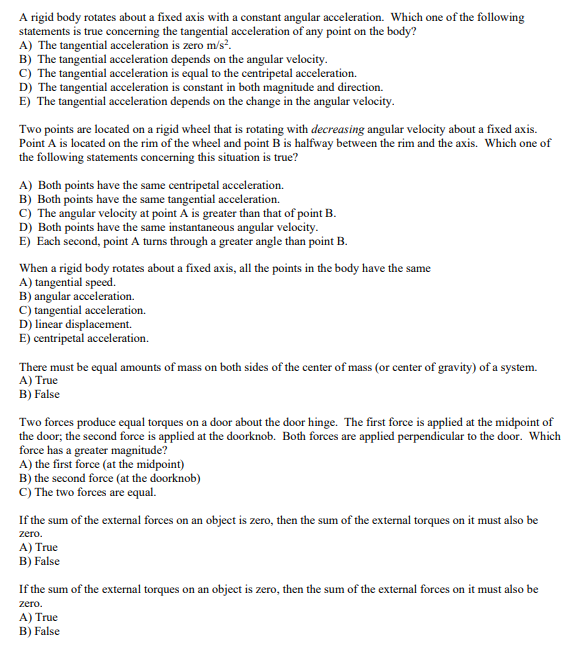A rigid body rotates about a fixed axis with a constant angular acceleration. Which one of the following statements is true concerning the tangential acceleration of any point on the body? A) The tangential acceleration is zero m/s². B) The tangential acceleration depends on the angular velocity. C) The tangential acceleration is equal to the centripetal acceleration. D) The tangential acceleration is constant in both magnitude and direction. E) The tangential acceleration depends on the change in the angular velocity.
A rigid body rotates about a fixed axis with a constant angular acceleration. Which one of the following statements is true concerning the tangential acceleration of any point on the body? A) The tangential acceleration is zero m/s². B) The tangential acceleration depends on the angular velocity. C) The tangential acceleration is equal to the centripetal acceleration. D) The tangential acceleration is constant in both magnitude and direction. E) The tangential acceleration depends on the change in the angular velocity.
Physics for Scientists and Engineers, Technology Update (No access codes included)
9th Edition
ISBN:9781305116399
Author:Raymond A. Serway, John W. Jewett
Publisher:Raymond A. Serway, John W. Jewett
Chapter10: Rotation Of A Rigid Object About A Fixed Axis
Section: Chapter Questions
Problem 10.2OQ: Consider an object on a rotating disk a distance r from its center, held in place on the disk by...
Related questions
Question

Transcribed Image Text:A rigid body rotates about a fixed axis with a constant angular acceleration. Which one of the following
statements is true concerning the tangential acceleration of any point on the body?
A) The tangential acceleration is zero m/s².
B) The tangential acceleration depends on the angular velocity.
C) The tangential acceleration is equal to the centripetal acceleration.
D) The tangential acceleration is constant in both magnitude and direction.
E) The tangential acceleration depends on the change in the angular velocity.
Two points are located on a rigid wheel that is rotating with decreasing angular velocity about a fixed axis.
Point A is located on the rim of the wheel and point B is halfway between the rim and the axis. Which one of
the following statements concerning this situation is true?
A) Both points have the same centripetal acceleration.
B) Both points have the same tangential acceleration.
C) The angular velocity at point A is greater than that of point B.
D) Both points have the same instantaneous angular velocity.
E) Each second, point A turns through a greater angle than point B.
When a rigid body rotates about a fixed axis, all the points in the body have the same
A) tangential speed.
B) angular acceleration.
C) tangential acceleration.
D) linear displacement.
E) centripetal acceleration.
There must be equal amounts of mass on both sides of the center of mass (or center of gravity) of a system.
A) True
B) False
Two forces produce equal torques on a door about the door hinge. The first force is applied at the midpoint of
the door; the second force is applied at the doorknob. Both forces are applied perpendicular to the door. Which
force has a greater magnitude?
A) the first force (at the midpoint)
B) the second force (at the doorknob)
C) The two forces are equal.
If the sum of the external forces on an object is zero, then the sum of the external torques on it must also be
zero.
A) True
B) False
If the sum of the external torques on an object is zero, then the sum of the external forces on it must also be
zero.
A) True
B) False
Expert Solution
This question has been solved!
Explore an expertly crafted, step-by-step solution for a thorough understanding of key concepts.
This is a popular solution!
Trending now
This is a popular solution!
Step by step
Solved in 2 steps

Knowledge Booster
Learn more about
Need a deep-dive on the concept behind this application? Look no further. Learn more about this topic, physics and related others by exploring similar questions and additional content below.Recommended textbooks for you

Physics for Scientists and Engineers, Technology …
Physics
ISBN:
9781305116399
Author:
Raymond A. Serway, John W. Jewett
Publisher:
Cengage Learning

Principles of Physics: A Calculus-Based Text
Physics
ISBN:
9781133104261
Author:
Raymond A. Serway, John W. Jewett
Publisher:
Cengage Learning

Physics for Scientists and Engineers: Foundations…
Physics
ISBN:
9781133939146
Author:
Katz, Debora M.
Publisher:
Cengage Learning

Physics for Scientists and Engineers, Technology …
Physics
ISBN:
9781305116399
Author:
Raymond A. Serway, John W. Jewett
Publisher:
Cengage Learning

Principles of Physics: A Calculus-Based Text
Physics
ISBN:
9781133104261
Author:
Raymond A. Serway, John W. Jewett
Publisher:
Cengage Learning

Physics for Scientists and Engineers: Foundations…
Physics
ISBN:
9781133939146
Author:
Katz, Debora M.
Publisher:
Cengage Learning

College Physics
Physics
ISBN:
9781285737027
Author:
Raymond A. Serway, Chris Vuille
Publisher:
Cengage Learning

College Physics
Physics
ISBN:
9781305952300
Author:
Raymond A. Serway, Chris Vuille
Publisher:
Cengage Learning

University Physics Volume 1
Physics
ISBN:
9781938168277
Author:
William Moebs, Samuel J. Ling, Jeff Sanny
Publisher:
OpenStax - Rice University